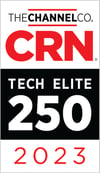Zero Trust security is a strategy, not a solution. The Zero Trust approach to security is governed by 2 key principles:
1) Never trust
2) Always verify
While Zero Trust security can’t be bought in the form of hardware or software, security tools can be used to build a Zero Trust Architecture (ZTA). These solutions focus on threat prevention and identity and access management for a defense against both internal and external threats that also generates business value. Forrester’s The Total Economic Impact™ Of Zero Trust Solutions From Microsoft found that companies that adopted Zero Trust solutions saw a 92% return on their investment.
Here’s a look at 3 of the top solutions needed for Zero Trust security:
1) Multi-Factor Authentication (MFA)
Multi-factor authentication (MFA) is a crucial part of identity and access management. With MFA, you use 2 or more factors to verify the identity of a user. These factors can be something you know, something you have, or something you are. MFA follows Zero Trust principles by explicitly verifying authority.
MFA is a vast improvement over using passwords, which can easily be cracked. Instead of relying on passwords, MFA uses one-time use access codes, tokens, personal questions, or biometrics in a layered approach to authenticating a user’s identity. These factors are much more difficult to hack, and if one factor doesn’t block unauthorized access, another probably will.
MFA is an effective defense against ransomware, business email compromise, and targeted phishing campaigns. According to Microsoft, MFA reduced the effectivity of identity-based attacks by over 99%.
2) Security Information and Event Management (SIEM)
Security information and event management (SIEM) allows your company to take a proactive approach to security, which is key in following Zero Trust principles. SIEM uses software to perform real-time analysis of security alerts to gain actionable threat intelligence that prevents risk.
The SIEM can capture information about threats from across your entire attack surface, including endpoints and cloud resources, and alert you to breach attempts before they succeed. The solution also compiles reports that can be used for compliance audits, as well as to identify and foil future cyberattacks.
3) Encryption
Encryption can protect data at rest and in transit when it is most vulnerable. With encryption, information is scrambled using an algorithm. Only the authorized recipient can decipher the information contained in the data. To read the data, the recipient must have a decryption key. Encryption renders data useless to hackers who might want to peddle it on the black market.
End-to-end encryption contributes to a Zero Trust Architecture because it distrusts all access attempts, preventing information from being stolen or compromised. Whether the access attempt is made by a cybercriminal or an employee at the wrong level of authority, if the user doesn’t have the key, encryption will protect the information from being used.
Building a Zero Trust Architecture
Zero Trust has become the standard for cybersecurity. However, companies may find themselves at various stages of maturity because Zero Trust takes an end-to-end approach to security, which focuses on users, assets, and resources, including endpoints.
Where is your company in your Zero Trust journey?
ProActive Solutions can help your company increase your Zero Trust maturity whether you are just starting out or already have some of the architecture in place. We focus on security and compliance, offering leading solutions for ZTA, including SIEM and MFA.
We take a consultative approach to security, working with your team to assess your current threat landscape and security strategy, uncover gaps, and design solutions to bridge them. Our areas of security expertise include identity and access management and threat prevention and management, which are both important parts of Zero Trust security.
Get on the path to adopting a Zero Trust approach to security. Ask for a security whiteboard session with ProActive.



